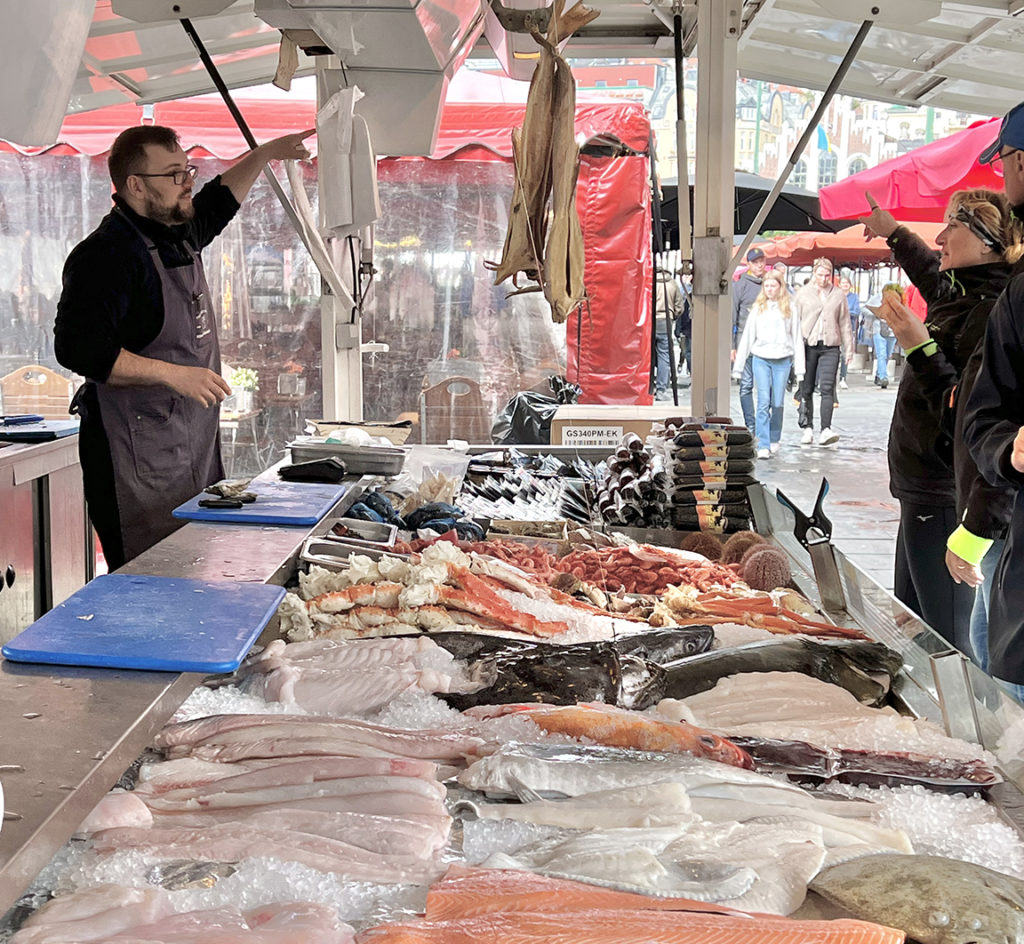
by Pam Johnson
Call of the gulls, mountains, and sea
Trees clinging to cliffs, lush valleys below
Contrast the bustling city,
Trams, bikes, and trains
Norway’s perfect harmony
Nature and high tech…coexisting.
Western Norway: A land of contrasts. The mountains and fjords are just a step away from vibrant cities….or, rather, the cities are built right into them. So it is with Bergen, our home for the month of July.
Bergen is known as the “Gateway to the Norwegian Fjords,” and it rests between two of them, the Hardangerfjord and the Sognefjord. A perfect location for a history of seafarers—from Vikings to traders to warships to today’s cruise ships.
Bergen is also called the “the city between seven mountains,” and they mean it literally. The multi-colored houses aren’t only in the valleys and along the shores, but they’re built straight up the sides of these mountains, with each window fighting for a view of the ocean or valley below.
Like many European cities, Bergen itself is a study in contrasts. Modern buildings stand next to medieval churches and cruise ships hover over a 13th century fortress. The quaint, narrow cobblestone roads and centuries-old buildings are nestled among busy streets teeming with electric scooters, bicycles, and the highly efficient light-rail.
Although most residents take the more modern forms of transportation (watch out for those electric scooters!), it is a city meant for walking. Many people walk, and they walk fast. And we walked right along with them. Miles and miles and miles over the past several weeks—umbrella in hand.
Bergen boasts 200 days of rain a year. And this year, most of them seemed to fall in July. The locals know to dress accordingly. The sidewalks and stores are filled with very hip rainwear. It had never occurred to me to own a matching rain pants and coat set, like my old ski bibs and jacket. In Bergen, it’s a necessity. Because not only is there rain, but wind. Just an umbrella doesn’t always work. We saw many umbrellas that met an early demise.
Johnson City News & Neighbor readers may appreciate this. When we Googled “English-speaking churches in Bergen,” up came the Bergen Anglican Church, where the chaplain, Reverend Dr. Kirk Weisz, is from Greeneville, TN! We knew we had to visit. As with our church in Scotland, this church became one of the most special things about our month in Norway.

The church meets in the oldest building in the city, St. Mary’s Church, dating back to the 12th century. Since it stands in the historic district where tourism is flourishing, and it’s next to the cruise ship port, and it’s English-speaking, the church caters to visitors from all over the world. They also serve Ukrainian refugees, so part of the service is in Ukrainian. If you ever get a chance to visit, please attend the after-church coffee hour. We made some dear friends there. Unfortunately, Rev. Kirk was away this month, so we didn’t get a chance to meet him. But it turns out my husband met his father when they both worked at Tusculum College. It truly is a small world.
The chaplain and his family weren’t the only ones away on holiday. The people of Norway tend to vacation in July. It’s their summer break, so many businesses, restaurants, and even churches were closed. Keep that in mind when planning your travels there. However, though the locals are rather quiet this month, tourism never stops. There are still plenty of things to do and sites to see.
Bergen is home to the Hanseatic (a medieval confederation of merchant guilds) wharf called Bryggen, a UNESCO World Heritage site. You may have seen photos of the classic “colorful wood houses” along the boardwalk. Those houses are now shops and restaurants, but their 1000-year history still permeates the air around them.
Right at the end of the wharf is the Bergen Fish Market, established in 1276. A delightful place to walk through and grab a fresh fish sandwich or bowl of paella (or for this vegetarian, a baked potato). It’s open, rain or shine (as everything needs to be). If you get a chance, look up old photos of the market and compare them to more modern ones. This whole area has seen so much change over the centuries.

What hasn’t changed is the magnificence of the mountains, countryside, and fjords. I’m from Alaska, so I know the majesty of mountains, but these are indescribable. Words and photos cannot capture their splendor; instead, they are something you must experience. I now understand why the Norwegian cruises, like Alaskan cruises, are so popular.
If you ever get to visit, but cannot do a full cruise of Western Norway, at least do the boat and train trip between Bergen and Flåm. Make sure you stop in the lovely inland town of Voss. It proves that the beauty of Norway is not only coastal, it saturates the whole country. There is breathtaking wonder everywhere you look.
But now, we leave the grandeur of the fjords and the lively city of Bergen for the peaceful countryside of Estonia, where we look forward to a different kind of cultural immersion: living at a monastery.
For more photos of Norway (and earlier photos of Scotland), please follow me on Instagram and TikTok at @amimionthemove and my blogsite at pamtheeditor.wixsite.com/amimionthemove.



